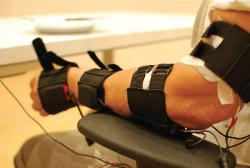Nov 28 2013
Studying the robotic devices for the sensorimotor rehabilitation of patients and to help to achieve functional compensation and assistance to elderly or disabled people are the challenges of Eduardo Rocon, who works at the Automatic and Robotic Center of the Technical University of Madrid (UPM) and the Spanish National Research Council (CSIC).

Eduardo Rocon was awarded this year with the Juan López de Peñalver Award for his contribution in the field of neuro-robotic. In a special way, the jury has valued the development of an exoskeleton that alleviates deficiencies of people suffering from temblors and cerebral palsy
Rocon, who earned his doctorate degree in Industrial engineering from UPM, researches on neurophysiology, biomechanics, and physical and cognitive interaction man-machine. His work at the Automatic and Robotic Center is focused on rehabilitation for diseases such as strokes, tremors, spinal injury or cerebral palsy. He also belongs to a research group that works on the development of neuroprothesis and integrated sensors in clothing.
In 2011, Rocon developed along with colleagues from Belgium, Italy, Denmark and Spain a neuroprothesis able to reduce the convulsions caused by Parkinson and other neurological diseases. The main benefit is its ability to distinguish whether a person aims to execute a voluntary movement such as when a person rises a glass with the intention of drinking its content, his arm can stabilize the movement to ease the performance.
The device monitors the motor activity of the patients by the synchronous acquisition of his muscular activity (electromyography) and his real movement which are characterized with sensors motion on the body extremities where the patient suffers the tremors.
A system of Functional Electrical Stimulation is responsible for the production of electrical currents on the affected member to reduce body convulsions. This would not affect the functionality of voluntary physical movements because the system selectively stimulates the muscles involved in the performance of a motor task affected by the temblor.
The final device has all elements integrated in a specially clothing design which adapts to the shape of an arm which contains an array of electrodes sewn inside the clothing that has the function to meet the demands of the potential users in terms of aesthetics and usability. The opportunity of a selective stimulation by an array of electrodes will allow more accurated results because it will reduce fatigue and the possible discomfort caused by electrical stimulation.
Basically, this mentioned system consists of a set of sensors that are able to measure the movement sequence action and uses this data to suppress tremor activity. The research line defined by this work contributes to develop the next generation of ready to wear robots designed for rehabilitation and for the assistance of elderly and disabled people which are a growing population within the European society that has special needs.
Pathological tremor is commonly the most widespread neuromotor disorder: it affects between 1 to 2% of the population, 6% of them are older than 60. Besides, its rate increases due to the progressive aging in our society. Although the tremor does not have direct effect on life expectancy, it does cause functional disability and it is a reason for social exclusion. In fact, 65% of people with seizures in the upper body extremities tend to have great difficulty to perform daily activities. These deficiencies have a high impact on patients and represent a high cost for public health system and social services.
Nowadays, this type of pathological tremor is treated with medication or deep brain stimulation. But 25% of patients do not respond well to these therapies. Therefore, the device created by Rocon and his colleagues does indeed provide an alternative for many patients. This alternative is a good example of the transition from the classic robots to the new robots which are an evolution towards robust devices. They are effective and acceptable by humans. All of this is commonly researched by CAR.